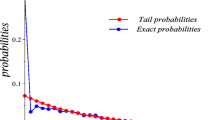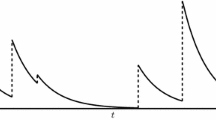Abstract
We analyze the queue at a buffer with input comprising sessions whose arrival is Poissonian, whose duration is long-tailed, and for which individual session detail is modeled as a stochastic fluid process. We obtain a large deviation result for the buffer occupation in an asymptotic regime in which the arrival rate nr, service rate ns, and buffer level nb are scaled to infinity with a parameter n. This can be used to approximate resources which multiplex many sources, each of which only uses a small proportion of the whole capacity, albeit for long-tailed durations. We show that the probability of overflow in such systems is exponentially small in n, although the decay in b is slower, reflecting the long tailed session durations. The requirements on the session detail process are, roughly speaking, that it self-averages faster than the cumulative session duration. This does not preclude the possibility that the session detail itself has a long-range dependent behavior, such as fractional Brownian motion, or another long-tailed M/G/∞ process. We show how the method can be used to determine the multiplexing gain available under the constraint of small delays (and hence short buffers) for multiplexers of large aggregates, and to compare the differential performance impact of increased buffering as opposed to load reduction.
Similar content being viewed by others
References
J. Abate and W. Whitt, Calculating transient characteristics of the Erlang loss model by numerical transform inversion, Stochastic Models, to appear.
V. Anantharam, How large delays build up in a GI/G/1 queue, Queueing Systems 5 (1988) 345-368.
V. Anantharam, On the sojourn time of sessions at an ATM buffer with long-range dependent input traffic, in: Proceedings of the 34th IEEE Conference on Decision and Control (December 1995).
N.H. Bingham, C.M. Goldie and J.L. Teugels, Regular Variation, Encyclopedia of Mathematics and its Applications, Vol 27 (Cambridge University Press, Cambridge, 1987).
A.A. Borovkov, Stochastic Processes in Queueing Theory (Springer, Berlin, 1976).
D.D. Botvich and N.G. Duffield, Large deviations, economies of scale, and the shape of the loss curve in large multiplexers, Queueing Systems 20 (1995) 293-320.
O. Boxma, Fluid queues and regular variation, Performance Evaluation 27–28 (1996) 669-712.
C.-S. Chang, Stability, queue length and delay of deterministic and stochastic queueing networks, IEEE Trans. Automat. Control 39 (1994) 913-931.
G.L. Choudhury and W. Whitt, Long-tail buffer-content distributions in broadband networks, Performance Evaluation 30 (1997) 177-190.
J.W. Cohen, On the tail of the stationary waiting-time distribution and limit theorems for the M/G/1 queue, Ann. Inst. H. Poincaré 8 (1972) 255-263.
C. Courcoubetis and R. Weber, Buffer overflow asymptotics for a switch handling many traffic sources, J. Appl. Probab. 33 (1996) 886-903.
D.R. Cox, Long range dependence: a review, in: Statistics: An Appraisal, eds. H.A. David and H.T. David (The Iowa State University Press, Ames, IA, 1984) pp. 55-74.
A. Dembo and O. Zeitouni, Large Deviation Techniques and Applications (Jones and Bartlett, Boston/London, 1993).
N.G. Duffield, On the relevance of long-tailed durations for the statistical multiplexing of large aggregations, in: Proceedings of the 34th Annual Allerton Conf. on Communication, Control and Computation (October 2–4, 1996).
N.G. Duffield, Economies of scale in queues with sources having power-law large deviation scalings, J. Appl. Probab. 33 (1996) 840-857.
N.G. Duffield and N. O'Connell, Large deviations and overflow probabilities for the general single-server queue, with applications, Math. Proc. Cambridge Philos. Soc. 118 (1995) 363-374.
A. Feldmann, On-line call admission for high-speed networks, Ph.D. thesis, School of Computer Science, Carnegie Mellon University (1995).
P.W. Glynn and W. Whitt, Logarithmic asymptotics for steady-state tail probabilities in a single-server queue, in: Studies in Applied Probability, J. Appl. Probab., Special Volume 31A, eds. J. Galambos and J. Gani (1994) 131-159.
D. Heath, S. Resnick and G. Samorodnitsky, Patterns of buffer overflow in a class of queues with long memory on the input stream, Ann. Appl. Probab., to appear.
J.Y. Hui, Resource allocation for broadband networks, IEEE J. Selected Areas Commun. 6 (1988) 1598-1608.
I. Iscoe, P. Ney and E. Nummelin, Large deviations of uniformly recurrent Markov additive processes, Adv. in Appl. Math. 6 (1985) 373-412.
P. Jelenkovic and A. Lazar, Asymptotic results for multiplexing subexponential on-off sources, Preprint (1996).
G. Kesidis, J. Walrand and C.S. Chang, Effective bandwidths for multiclass Markov fluids and other ATM sources, IEEE/ACM Trans. Networking 1 (1993) 424-428.
T. Konstantopoulos and S.J. Lin, Fractional Brownian approximations of queueing networks, in: Stability and Rare Events, Lecture Notes in Statistics 117, eds. P. Glasserman, K. Sigman and D.D. Yao (Springer, New York, 1996) pp. 257-273.
W.E. Leland, M.S. Taqqu, W. Willinger and D.V. Wilson, On the self-similar nature of Ethernet traffic, ACM SIGCOMM Computer Communications Review 23 (1993) 183-193.
N. Likhanov, B. Tsybakov and N.D. Georganas, Analysis of an ATM buffer with self-similar (“fractal”) input traffic, in: Proc. IEEE INFOCOM '95, Boston (April 1995) pp. 985-992.
Z. Liu, P. Nain, D. Towsley and Z. Zhang, Asymptotic behavior of a multiplexer fed by a long-range dependent process, CMPSCI Technical Report 97-16, University of Massachusetts at Amherst (1997).
B.B. Mandelbrot and J.W. Van Ness, Fractional Brownian motions, fractional noises and applications, SIAM Rev. 10 (1968) 422-437.
I. Norros, A storage model with self-similar input, Queueing Systems 16 (1994) 387-396.
A.G. Pakes, On the tails of waiting-time distributions, J. Appl. Probab. 12 (1975) 556-564.
M. Parulekar and A. Makowski, Tail probabilities for a multiplexer with self-similar traffic, in: Proc. IEEE INFOCOM '96, San Francisco (March 26–28, 1996) pp. 1452-1459.
M. Parulekar and A. Makowski, Tail probabilities for M/G/∞ input processes (I): preliminary asymptotics, Preprint, University of Maryland (1996).
M. Parulekar and A. Makowski, M/G/∞ input process: a versatile class of models for network traffic, in: Proc. IEEE INFOCOM '97, Kobe (April 7–11, 1997).
V. Paxson and S. Floyd, Wide-area traffic: the failure of Poisson modeling, IEEE/ACM Trans. Networking 3 (1995) 226-244.
R.T. Rockafellar, Convex Analysis (Princeton University Press, Princeton, 1970).
A. Simonian and J. Guibert, Large deviations approximation for fluid queues fed by a large number of on-off sources, in: Proceedings of ITC 14, Antibes (1994) pp. 1013-1022.
Author information
Authors and Affiliations
Rights and permissions
About this article
Cite this article
Duffield, N. Queueing at large resources driven by long-tailed M/G/∞-modulated processes. Queueing Systems 28, 245–266 (1998). https://doi.org/10.1023/A:1019134703358
Issue Date:
DOI: https://doi.org/10.1023/A:1019134703358




